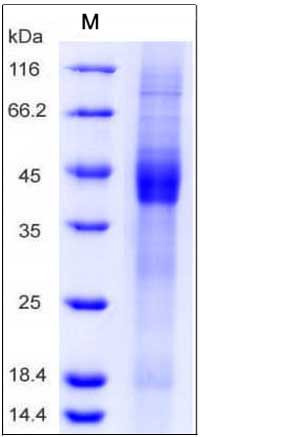Human IGFBP3 / IBP3 Protein (His Tag)
BP-53,IBP3
- 100ug (NPP3987) Please inquiry
| Catalog Number | P10430-H07H |
|---|---|
| Organism Species | Human |
| Host | Human Cells |
| Synonyms | BP-53,IBP3 |
| Molecular Weight | The secreted recombinant human IGFBP3 comprises 280 amino acids with a predicted molecular mass of 31 kDa. As a result of glycosylation, the apparent molecular mass of rhIGFBP3 is approximately 40-45 kDa in SDS-PAGE under reducing conditions. |
| predicted N | His 1 |
| SDS-PAGE |  |
| Purity | > 85 % as determined by SDS-PAGE |
| Protein Construction | A DNA sequence encoding the mature form of human IGFBP3 (NP_000589.2) (Gly28-Lys 291) was fused with a polyhistidine tag at the N-terminus. |
| Bio-activity | 1. Measured by its binding ability in a functional ELISA. Immobilized human IGF2 (P13032-H24E) at 10 μg/mL (100 μl/well) can bind biotinylated Human His-IGFBP3, The EC50 of biotinylated Human His-IGFBP3 is 18 ng/mL. 2. Measured by its binding ability in a functional ELISA. Immobilized human IGF1 (P10598-H24E) at 10 μg/mL (100 μl/well) can bind biotinylated Human His-IGFBP3, The EC50 of biotinylated Human His-IGFBP3 is 24 ng/mL. 3. Measured by its ability to inhibit the biological activity of IGFI or IGFII on MCF7 human breast adenocarcinoma cells (Karey, K.P. et al. (1988) Cancer Research 48:4083.). The ED50 for this effect is typically 0.02-0.2 μg/mL in the presence of 14 ng/mL human IGFII. |
| Research Area | Signaling |Signal Transduction |Growth Factor & Receptor |Insulin-like Growth Factor (IGF) System |IGF Binding Protein & Regulator |
| Formulation | Lyophilized from sterile PBS, pH 7.4 1. Normally 5 % - 8 % trehalose, mannitol and 0.01% Tween80 are added as protectants before lyophilization. Specific concentrations are included in the hardcopy of COA. |
| Background | The Insulin-like Growth Factor (IGF) signaling system plays a central role in cellular growth, differentiation and proliferation. IGFBP3 is the most abundant IGF binding protein in human serum and has been shown to be a growth inhibitory, apoptosis-inducing molecule, capable of acting via IGF-dependent and IGF-independent mechanisms. It appears to function both by cell cycle blockade and the induction of apoptosis. IGFBP3 can be transported to the nucleus by an importin beta mediated mechanism, where it has been shown to interact with the retinoid X receptor alpha and possibly other nuclear elements. IGFBP3 antiproliferative signalling appears to require an active transforming growth factor beta (TGF-beta) signalling pathway, and IGFBP3 stimulates phosphorylation of the TGF-beta signalling intermediates Smad2 and Smad3. IGFBP3 has IGF-independent roles in inhibiting cell proliferation in cancer cell lines. Nuclear transcription factor, retinoid X receptor (RXR)-alpha, and IGFBP3 functionally interact to reduce prostate tumor growth and prostate-specific antigen in vivo. Several clinical studies have proposed that individuals with IGFBP3 levels in the upper range of normal may have a decreased risk for certain common cancers. This includes evidence of a protective effect against breast cancer, prostate cancer, colorectal cancer, and lung cancer. Moreover, IGFBP3 inhibits insulin-stimulated glucose uptake into adipocytes independent of IGF. |
| Reference |
